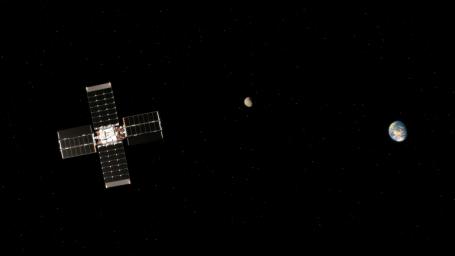This illustration shows NASA's Lunar Flashlight carrying out a trajectory correction maneuver with the Moon and Earth in the background. Powered by the small satellite's four thrusters, the maneuver is needed to reach lunar orbit.
Lunar Flashlight launched Nov. 30, 2022, and will take about four months to reach its science orbit to seek out surface water ice in the darkest craters of the Moon's South Pole. A technology demonstration, the small satellite, or SmallSat, will use a reflectometer equipped with four lasers that emit near-infrared light in wavelengths readily absorbed by surface water ice.
To achieve the mission's goals with the satellite's limited amount of propellent, Lunar Flashlight will employ an energy-efficient near-rectilinear halo orbit, taking it within 9 miles (15 kilometers) of the lunar South Pole and 43,000 miles (70,000 kilometers) away at its farthest point. Only one other spacecraft has employed this type of orbit: NASA's Cislunar Autonomous Positioning System Technology Operations and Navigation Experiment (CAPSTONE) mission, which launched in June 2022.
Lunar Flashlight is managed for NASA by the agency's Jet Propulsion Laboratory, a division of Caltech in Pasadena, California. Barbara Cohen, the mission's principal investigator, is based at NASA's Goddard Space Flight Center in Greenbelt, Maryland. Lunar Flashlight will be operated by Georgia Tech, including graduate and undergraduate students. The Lunar Flashlight science team is distributed across multiple institutions, including Goddard; the University of California, Los Angeles; Johns Hopkins University Applied Physics Laboratory; and the University of Colorado.
The SmallSat's propulsion system was developed by NASA's Marshall Space Flight Center in Huntsville, Alabama, with development and integration support from Georgia Tech. NASA's Small Business Innovation Research program funded component development from small businesses, including Plasma Processes Inc. (Rubicon) for thruster development, Flight Works for pump development, and Beehive Industries (formerly Volunteer Aerospace) for specific 3D-printed components. The Air Force Research Laboratory also contributed financially to the development of the Lunar Flashlight propulsion system. Lunar Flashlight is funded by the Small Spacecraft Technology program within NASA's Space Technology Mission Directorate.

 Planetary Data System
Planetary Data System












